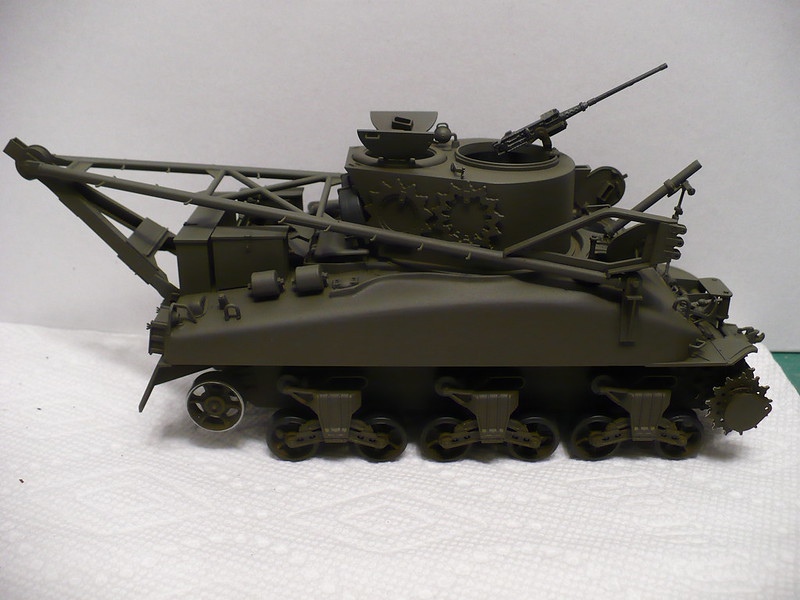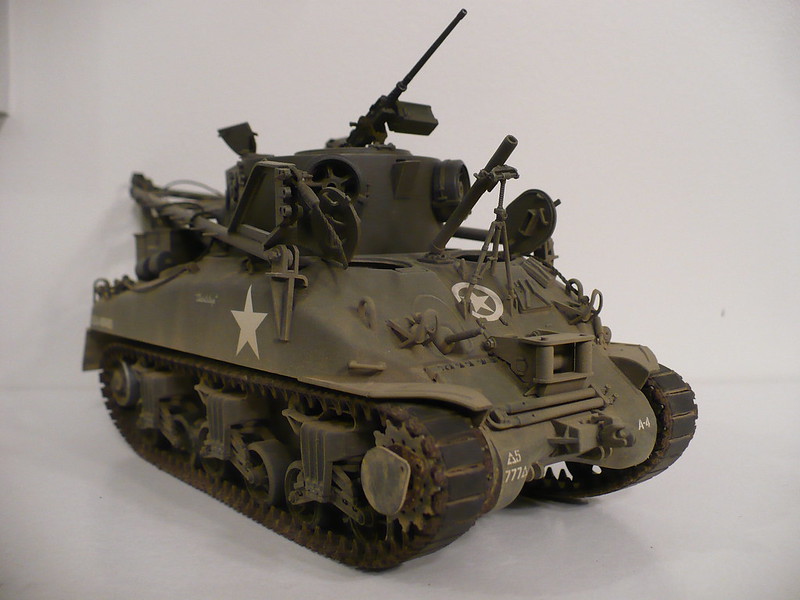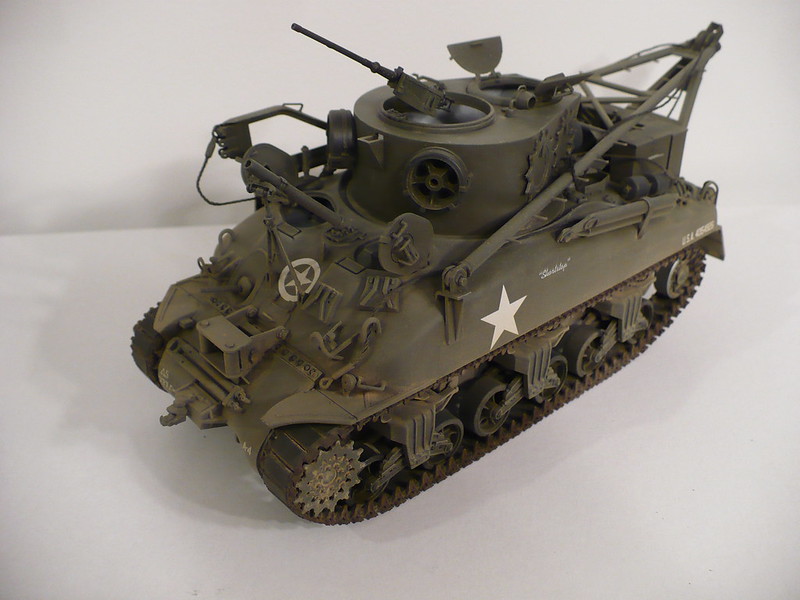|
|
Post by JEFF on Dec 28, 2017 4:31:48 GMT -6
Sounds like you got that pre-shade stuff figured out, Buddy. Give Her heck.
|
|
|
|
Post by dogfish7 (R.I.P.) on Dec 28, 2017 9:35:52 GMT -6
And fun to watch, too.
|
|
|
|
Post by Dukemaddog on Dec 28, 2017 13:32:53 GMT -6
Very nice looking model so far. Great job on the primer.
|
|
reserve
GAINING SPEED
 
Posts: 683
Likes: 1,758
|
Post by reserve on Dec 30, 2017 19:08:52 GMT -6
Thanks gents
Well the preshade came to naught; my own fault. I used Tammy acrylic OD and not being used to this paint did not get it near thin enough, saw it on the first shot but it was too late. Excellent paint by the way I'll be using it more. It came out dark, so dark it almost absorbed all the light in the room. After giving the problem some thought I mixed up a batch of MM faded OD about 70/30 with thinner and began misting the model, mostly from directly overhead
 002 by Mark Hartig, on Flickr 002 by Mark Hartig, on Flickr
 003 by Mark Hartig, on Flickr 003 by Mark Hartig, on Flickr
I used an Academy Ma Deuce, the Italeri one left a lot to be desired.
When it cures up I'll probably use the same AB technique to a lesser degree with MM enamel Lichtgrau along with some drybrushing of the same paint. I've found this color fades and ages OD wonderfully. Given tank retrievers were not slugging it out with the enemy I expect they lasted long enough to get an aged look to them; I read somewhere that the average life expectancy of an AFV in WW II was six weeks which is why I usually don't get too wild with faded paint
Regards, Mark |
|
|
|
Post by JCON on Dec 30, 2017 19:29:21 GMT -6
Looking nice and smooth Mark!!!  |
|
|
|
Post by dogfish7 (R.I.P.) on Dec 30, 2017 20:50:44 GMT -6
Stunning work Mark!
|
|
|
|
Post by JEFF on Dec 31, 2017 4:36:58 GMT -6
Looking right smart, MR.H.  |
|
|
|
Post by Beekster on Dec 31, 2017 10:26:20 GMT -6
Looking good, Mark! You're right that AFV's in combat usually had short lives, but the figure is deceptive. A tank was combat-lossed if it lost a bogie to a mine, for example, but might well be back in service a few days later. And as you correctly note, rigs like tank retrievers rarely were working under serious fire and loss rates were quite low. American armor in particular was resistant to chipping and fading during the expected time frame of wartime operations. This is because the paint itself was of high quality and baked on for durability; a legacy of the fact that our locomotive and car manufacturers were drawn into tank production. Much of what modelers think is faded paint is usually just ground-in dust on the matte paint surface, and most of the scratches are simply places where abrasion by foliage had disturbed the embedded dirt. American armor didn't suffer from poor paint adhesion with spots of rust that dripped rusty trails down the sides as a general rule. Camouflage colors were not applied with the same care as the factory finish, so those surfaces would chip and scratch more easily to reveal the more durable surface beneath.
|
|
reserve
GAINING SPEED
 
Posts: 683
Likes: 1,758
|
Post by reserve on Dec 31, 2017 11:01:30 GMT -6
Beekster you're right, seems to me I read that about paint somewhere also, perhaps in the same book but I'd forgotten it as it's been some years ago. Have you read Belton Cooper's "Deathtraps"? Not an over pleasant read but descriptive of US armor in the ETO
Regards,
Mark
|
|
|
|
Post by Beekster on Dec 31, 2017 12:23:35 GMT -6
Beekster you're right, seems to me I read that about paint somewhere also, perhaps in the same book but I'd forgotten it as it's been some years ago. Have you read Belton Cooper's "Deathtraps"? Not an over pleasant read but descriptive of US armor in the ETO Regards, Mark Yes, that one is part of my library. A good read, but overly critical of the Sherman. Doctrine determines design, and the Sherman was designed for infantry support and not long-range gunnery duels with the relatively rare German heavies (only about 5,000 Panthers produced and about 1,800 Tiger I/II). Cooper was traumatized by the loss rates suffered in Normandy and the gruesome nature of his job as a tank recovery specialist, which is certainly understandable. But his gripes about the Sherman ignore the fact that it was being forced to do things it wasn't designed to do. Sure, we eventually realized that the whole "tanks do this, tank destroyers do that" thinking was bogus and we needed a tank that could do it all, but that wasn't evident in early 1942 when the Sherman was designed. And getting new equipment in the pipeline takes time. The Pershing was a perfect answer to the German heavies, and it could not have arrived much sooner than it did...no more than nine months at best, and even that presupposes that the slightly less well armored T-25 prototype had been standardized instead of the heavier T-26 that grew out of it a few months later. |
|
|
|
Post by Dukemaddog on Dec 31, 2017 14:17:14 GMT -6
I love this discussion on the paint properties and the relative merits of Cooper and his book. I also have "Deathtraps" and I came away with a similar appreciation of the book as Beekster. It would have been interesting to see how things would have developed if the Pershing were available sooner than later. Still, the Sherman soldiered on admirably given how it was used, and was much admired to one degree or another by both the Soviets and the Germans who used them whenever they found them.
This is such a great Forum! Keep the awesome work and the great information coming!
|
|
|
|
Post by Beekster on Dec 31, 2017 14:57:33 GMT -6
The Russians liked the fact that the Sherman just kept running and running, unlike the T-34 which had issues with transmission failure. The Russians put their Shermans in second-echelon formations intended to exploit into the Germans' operational depth once the breakthrough had been made, because they knew that they would lose very few tanks to breakdowns and the combat strength of the formation wouldn't drop off with distance. The Germans were dismissive of the armor and gun power of the Shermnan, but used them anyway for the same mechanical reasons...and because their low production rates and inefficient industrial management meant that there were never enough tanks to go around. Daimler-Benz made great cars then and now, but their Panthers and every other German tank were very complex machines that broke down often (again, transmission failures were common, especially as tanks got heavier) and were far more difficult to repair in the field than the Sherman. Even the Germans themselves admitted that.
|
|
reserve
GAINING SPEED
 
Posts: 683
Likes: 1,758
|
Post by reserve on Jan 3, 2018 0:12:37 GMT -6
So this has come as far as it's going to until UPS does its thing and coughs up some more goodies
 001 by Mark Hartig, on Flickr 001 by Mark Hartig, on Flickr
 002 by Mark Hartig, on Flickr 002 by Mark Hartig, on Flickr
 003 by Mark Hartig, on Flickr 003 by Mark Hartig, on Flickr
Italeri gives no provisions to attach the cables to the boom, so the parts box yielded some clevasses and cable ends. A bit of .030 wire and some hex rod completed the deal
 006 by Mark Hartig, on Flickr 006 by Mark Hartig, on Flickr
 007 by Mark Hartig, on Flickr 007 by Mark Hartig, on Flickr
I'll add the tools, fix the whoopses and fine tune it once UPS hacks up
Regards, Mark |
|
|
|
Post by JCON on Jan 3, 2018 0:26:17 GMT -6
Very nice additions!!!!
|
|
|
|
Post by BUCKY on Jan 3, 2018 0:57:27 GMT -6
Those cables look very real!
|
|
|
|
Post by Beekster on Jan 3, 2018 9:23:37 GMT -6
Very well executed!
|
|
|
|
Post by JED on Jan 3, 2018 10:03:03 GMT -6
Glad I caught up with this lovely build, some interesting info going on also 👍👍
|
|
|
|
Post by dogfish7 (R.I.P.) on Jan 3, 2018 11:39:02 GMT -6
Excellent photography.
|
|
|
|
Post by JEFF on Jan 3, 2018 15:52:59 GMT -6
Total coolness, Mark. This is looking great.  |
|
|
|
Post by ARMORGUY on Jan 5, 2018 15:44:02 GMT -6
An olive drab beauty, great cabling btw !
|
|